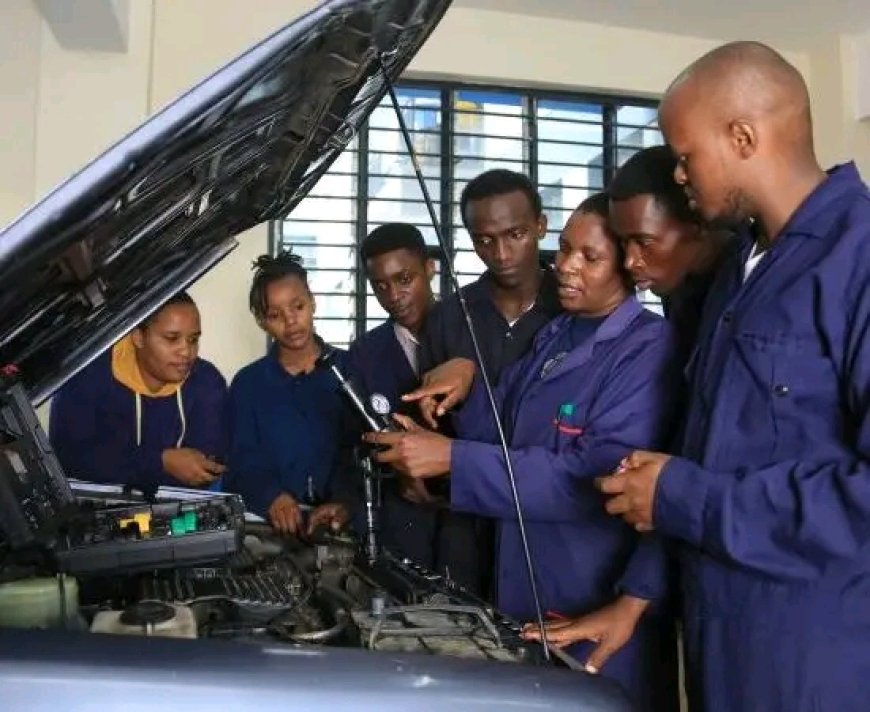Government upgrades Vocational training to tackle joblessness and artisans' skills gap

Nakuru
Thursday, August 10, 2023
KNA by Esther mwangi
The National Industrial Training Authority (NITA) is working with Technical Vocational Education Training Institutions (TVETs) to promote creativity and innovation in learning institutions in order to provide the youth with competitive skills for self-employment and help close the practical skills gap in the country’s labour market.
NITA Chairperson Mr Aden Noor Ali said their collaboration with TVETs seeks to provide young people with competitive skills for self-employment or jobs in the informal sector and to make vocational training appealing to the youth while addressing unemployment as well as the shortage of technical skills in domestic and commercial sectors.
Mr. Ali noted that though the world was struggling with youth unemployment, it was experiencing a skills shortage adding that skills development and transformation was crucial for Kenya’s economic growth and development.
“Skills development is a key driver for employability, poverty eradication, sustained social and economic growth and cohesion,” stated Mr Ali.
He said the Kenya Kwanza administration had recognized that skills development was vital for the country’s growth and had prioritized it in its development agenda where the country’s skills ecosystem was now focusing on predicting how the need for skills will change and the preparedness to be responsive.
Speaking at the Kenya Industrial Training Institute (KITI) in Nakuru when he oversaw a trade test for 626 candidates from 21 centres Mr Ali said the State was working closely with TVETs, universities and polytechnics to ensure skills produced are useful in the future work world.
“We are determined to put a stop to the mismatch between the skills the students graduate with and industry needs by equipping our learners with capacities to anticipate and be aware of labour market dynamics,” he added.
Mr Ali revealed that the total number of candidates who had sat for the trade test nationally were 14,130 with Grade One, Two and Three accounting for 651 candidates, 3,180 and 10,288 candidates respectively. An additional 11 candidates were awarded Master Crafts person certificates.
The NITA chairperson said the skills mismatch was a result of weak linkage between education and industry leading to unemployment, which disproportionately affects the youth, who account for 75 percent of the current population of around 50 million people.
The skills mismatch, according Mr Ali, happens at two levels: micro and macro level where at micro level, he said it includes over skilling or under skilling and also skills obsolesce and geographical gaps where there are opportunities in an area but the skills supplies are in a different location. At macro level, he said the mismatch was the issue about supply and demand of skills.
At the same time, Mr Ali said that skills mismatch was a key challenge facing the youth leaving post school levels of education and training, adding that there was a disconnect between the courses offered in higher education institutions and the needs in the job market.
“Higher education institutions need to offer courses that are relevant to the current job market. Those that offer courses that are practical to the current dynamics, they should properly guide the youth on the career selections so that they do not end up being unemployed years even after training,” he added.
The Chairman said there was need to build and incorporate soft skills such as communication, respect, public relations and financial literacy into the school and post-school curricular.
He also said there should be mentorship and coaching programmes at workplaces, where newly recruited staff are placed under experienced officers to understudy them.
Mr Ali indicated that addressing youth unemployment and under-employment required both job creation and skills development adding that there was need for deliberate concerted efforts by the various players and actors to inform the youth about the options available and dynamics in the labour market in addition to providing Competency-Based Education and Training (CBET) as well as imparting life and communication skills.
KITI Principal Ms Peris Adema said there was need to develop appropriate labour market information systems due to lack of access to real-time labour market data, which would entail undertaking skills inventory to inform areas for skills training and trace studies in order to track TVET graduates in the labour market.
By so doing, the principal said it will give feedback for review and improvement of TVET programmes and improving employability.
“Strengthening the linkages between education and training through collaboration between the training institutions and labour market, private sector needs to be vigorously involved in shaping the future of industry by playing key roles in the planning and design of TVET programmes,” said Ms Adema.
Employers, she added, need to collaborate with training institutions to provide practical training focusing on demand-driven skills and as a result, there will be the creation of a pool of skilled workers.
Ms Adema noted that aligning training with industrial needs can have a ripple effect on the economy because businesses are likely to expand and create new jobs if they are able to find the talents they need.
The Economic Survey 2023 shows that the age groups between 20-24 years and 25-29 years continue to record the highest proportion of the unemployed at 16.3 per cent and 9.1 per cent, respectively.
Individuals aged 20 to 24 without jobs grew to 580,281, while those between 25 and 29 increased to 351,125, the survey revealed.
Courtesy ; K. N. A
What's Your Reaction?
































































































































































































































































































